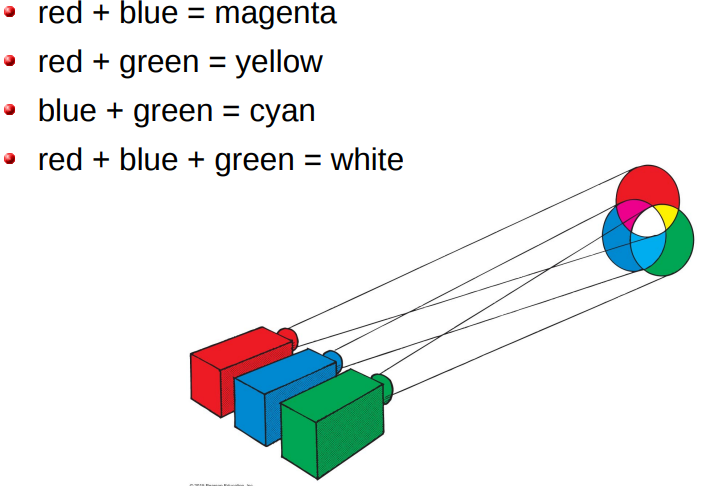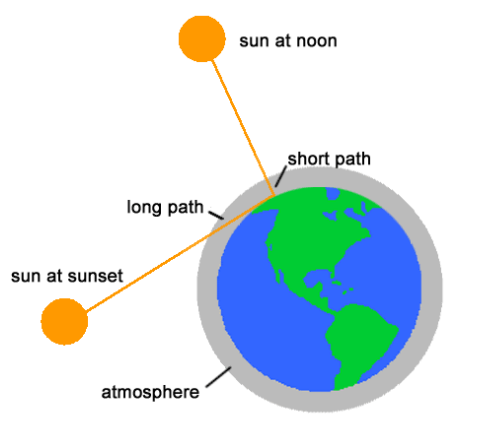PY 131 Chapter 27: Color
Color
In order to see something an object must either emit (visible) light or scatter/reflect light toward our eyes.
Most objects do not emit visible light and are seen due to reflection/scattering.
All objects are emitting light but typically it’s not light we can see with our eyes, its infrared
The principle source of light that is scattered/reflected is light from the Sun which is a mixture of light with lots of different frequencies.
We call visible light which is a more-or-less equal mixture of all frequencies white light.
What we call color is light which is dominated by a small range of the visible spectrum.
The ranges of colors are:
Violet: 380–450 nm
Blue: 450–495 nm.
Green: 495–570 nm.
Yellow: 570–590 nm.
Orange: 590–620 nm.
Red: 620–750 nm
When white light strikes an object some of the light is absorbed and some is reflected/scattered.
If the reflected light is predominantly a particular frequency then we perceive the object to have a color.
For example: leaves look green because they absorb most of the other frequencies of visible light and scatter the green.
Absorbing some colors and reflecting others is called selective reflection
An object can only look to have a particular color if that color of light is present in the light from the source.
For example, you have an object which has a red color when white light is shone upon it
If you shine pure red light upon it then the object will continue to look red, but if you shine green light upon it there is no red light to reflect and so the object will look black.

In some cases light can pass through an object, however, the amount that passes through can depend on the color.
So if white light is incident upon such an object, the light that emerges can be missing certain colors and thus the object appears to have a color.
i.e. the object subtracts a color from white light leaving it non-white.
Creating a color after light passes through something is called selective transmission.

Additive Mixing
It is thought that the eye determines color by the relative response of the different cones found on the retina.
The human eye can distinguish about 10 million different colors.
For example: an object appears red because the L-cones are strongly activated, the M-cones only somewhat, and the S-cones hardly at all.
Thus any color can be simulated by combining the light emitted from three sources with three different colors chosen so that they stimulate the three types of cones found on the retina by different amounts.
The colors of the light sources are often chosen to be red, green and blue because they produce a large number of colors when combined.
This way of producing color is called additive mixing (of light).
red + blue = magenta
red + green = yellow
blue + green = cyan
red + blue + green = white

Note that the yellow light created by mixing red and green light is not actually yellow, it just stimulates the eye the same way yellow light does.
EXAMPLE 1
What color will a blue object will appear illuminated with a) blue light, b) cyan light, c) yellow light, and d) magenta light?
A) blue – blue light is entirely blue
B) blue – cyan light is a mixture of green and blue,
C) black – yellow light a mixture of red and green
D) blue – magenta light is a mixture of red and blue
Subtractive Mixing
The alternative to adding light to make a color is to start with white light and remove the colors you don’t want.
This technique of producing color is called subtractive mixing.
For example: starting with white light and removing the red-orange light and the blue-violet leaves just the yellow-green.
Substances which remove light from white light are known as dyes, pigments or inks.
At a minimum three different inks are needed to produce a particular color (you have three types of cones in your eyes).
more than three is better but more inks means more expense.
The most common choice for the three inks are yellow, magenta and cyan.
Sometimes black ink is used too because the black produced by mixing yellow, magenta and cyan is too pale.
When looking at a color picture, light travels through the ink, reflects off the paper, then travels through the ink again.
The ink removes a color from white light.
yellow ink removes blue from white light
magenta ink removes green from white light
cyan ink removes red from white light

EXAMPLE 1
What color do you get in a color picture if you print Magenta and Yellow over one another?
Red
Explanation: The yellow ink removes the blue from white light leaving red and green. The magenta removes the green leaving just the red.
Why is the sky blue?
If the light scattered by something is preferentially a particular wavelength, the scattered light will have a color.
This method of giving something a color is called selective scattering.
The sky (atmosphere) is not intrinsically blue, the blue color is because the atmosphere preferentially scatters the blue wavelengths of the sunlight (which is white).
The atmosphere contains tiny amounts of particulate matter e.g. smoke.
These particles scatter blue light most effectively, green light somewhat effectively, and red light least effectively.
The sky is blue because we are seeing the scattered blue light.

If the sunlight has to travel through a lot of atmosphere then the light directly from the Sun is also missing the green light.
This occurs at sunrise/sunset and so the Sun appears red.

Water droplets also scatter sunlight but they scatter all colors about equally so clouds appear white.
some of the sunlight gets absorbed which darkens the cloud.
Why is water blue?
Large bodies of water appear blue/green not because they selectively scatter blue/green sunlight but rather because they selectively absorb red light.

Removing red light from white leaves blue and green which give cyan.
 Knowt
Knowt
